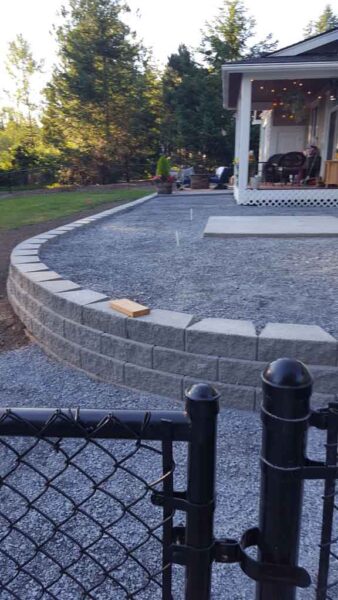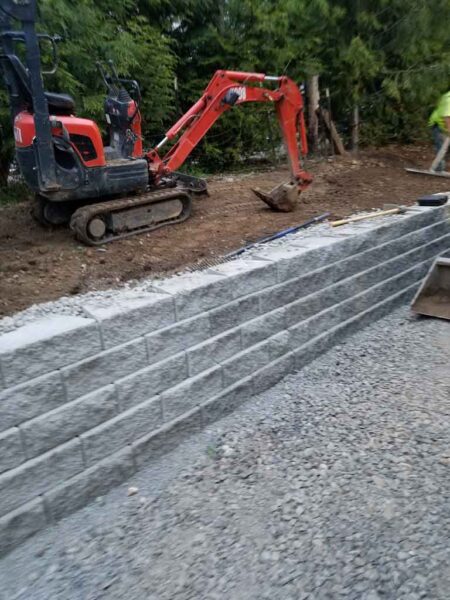Professional retaining wall services are the way to enhance your property and address landscape challenges. These sturdy structures are essential for managing slopes, preventing erosion, and creating usable spaces on hilly or uneven terrain.
Working with expert contractors in Snohomish County ensures that your retaining walls not only fulfill their purpose but also add aesthetic value to your property.
Professional retaining wall services in Snohomish County offer tailored solutions to meet your specific needs, whether for new construction, repairs, or landscape overhaul.
Experienced contractors can handle all aspects, including design, permits, and construction, ensuring a hassle-free experience for you.
Investing in professional retaining wall services also means peace of mind. Licensed and bonded contractors bring workmanship and reliability that guarantees durability and safety.
Understanding Retaining Walls
Understanding retaining walls is crucial for any landscaping project involving soil retention. Performance and durability depend on the type used and the quality of the installation.
Types of Retaining Walls
There are several types of retaining walls that you can use in your landscape project. The most common include Gravity Walls, Cantilever Walls, and Segmental Retaining Walls.
- Gravity Walls: These rely on their weight to hold back soil and are made from heavy materials like stone or concrete.
- Cantilever Walls: These use a reinforced base to leverage soil weight. They are often constructed from reinforced concrete.
- Segmental Retaining Walls use interlocking blocks, offering flexibility in design and making them easier to install without mortar.
Benefits of Professional Installation
Hiring professionals for your retaining wall installation has several benefits.
- Expertise: Professionals understand soil mechanics, proper drainage, and the complexities of structural integrity.
- Materials: They can recommend and source the best materials suited for your specific needs.
- Safety: Experts ensure compliance with local building codes, reducing the risk of structural failure.
- Aesthetics: Professional installations often look better and add more value to your property.
Design and Planning
Professional retaining wall services include detailed design and careful planning to ensure stability, durability, and visual appeal. These stages must address site conditions, choose appropriate materials, and apply reliable design concepts.
Site Analysis and Preparation
Before construction starts, examining the site’s conditions thoroughly is vital. This involves surveying the area, checking the soil composition, and identifying any existing drainage problems.
You must consider factors like slope, soil type, and local climate.
Proper grading ensures water flows away from the wall, preventing erosion and water damage.
Also, getting the proper permits and adhering to local building codes is essential. These steps help create a solid foundation that will effectively support the retaining wall.
Understanding retaining walls is crucial for any landscaping project involving soil retention. Performance and durability depend on the type used and the quality of the installation.
Material Selection
Choosing the right materials is vital for the wall’s structural integrity and aesthetic appeal.
Common materials include concrete blocks, natural stone, brick, and timber.
- Concrete blocks: Durable and versatile
- Natural stone: Aesthetic and blends well with landscapes
- Brick: Classic look, good for residential areas
- Timber: Cost-effective, but needs more maintenance
Your choice depends on the site’s conditions and your budget. Proper material selection ensures the wall withstands environmental factors while complementing the landscape design.
Retaining Wall Design Concepts
Design concepts for retaining walls focus on both functionality and appearance.
Gravity walls rely on their weight to hold back the soil, while cantilever walls use an internal lever system.
Sheet piling walls are useful in tight spaces. Anchored walls provide additional support using cables or rods.
To manage water flow, the design should incorporate drainage solutions like weep holes and drainage pipes. This prevents pressure buildup behind the wall, reducing the risk of failure.
Construction Process
Creating a sturdy and long-lasting retaining wall involves several steps. These include excavation, establishing a solid foundation, ensuring proper drainage and backfilling techniques, and meticulously assembling wall materials.
Each step is crucial to the structural integrity and functionality of the wall.
Excavation and Foundation
The first step in building a retaining wall is excavation. You need to dig a trench where the wall will stand.
The size of the trench depends on the type and height of the wall. The trench should be about twice as wide as the blocks or materials used for the wall, on average.
A solid foundation is essential. Use crushed stone or gravel to fill the bottom of the trench.
This base layer should be compacted and leveled for stability. The depth of this base often ranges between 6-12 inches, depending on the wall’s height.
Laying the initial row of wall blocks on this foundation is critical. Ensure each block is level and aligned properly since this row determines the stability and alignment of the entire wall.
Drainage and Backfill
Proper drainage is vital to preventing water build-up behind the wall, which can lead to pressure and potential failure.
Install a perforated drain pipe at the base, sloping slightly to direct water away from the wall. Cover this pipe with gravel for improved drainage.
Backfilling involves placing material behind the wall as it is built up. Avoid using soil, as it can compact and retain water.
Layer the backfill in increments, compacting each layer to ensure a solid and stable fill.
It’s important to backfill and compact as you go, rather than waiting until the end.
Wall Construction and Assembly
Building the wall involves stacking the blocks, bricks, or other materials according to the design.
Interlocking blocks provide added stability and are often used for ease and durability. Stagger the joints with the row below for each layer to enhance the wall’s strength.
Secure blocks in place using mortar or adhesives, especially for taller walls. Follow the manufacturer’s instructions for applying these materials.
As the wall rises, periodically check for level and alignment. Mistakes in the early stages can become problematic if not corrected.
Build, backfill, and compact until the wall reaches the desired height.
Maintenance and Repair Services
Regular maintenance and timely repairs are essential to keep retaining walls in good shape. Inspections can identify problems early, while understanding common issues helps plan fixes.
Routine Inspection and Maintenance
Routine inspections are vital for the health of your retaining wall.
Check the wall regularly for cracks, bulges, and water damage. Assess the wall’s alignment to ensure it remains level and straight.
Annual inspections by professionals can catch problems early, preventing major damage.
Cleaning the wall to remove dirt, plants, and debris prolongs its life and maintains its appearance.
Common Issues and Repairs
Common issues with retaining walls include cracks, leaning, and water damage.
Cracks can occur due to ground movement or water penetration. Repairing cracks early stops them from spreading.
Leaning walls are often a sign of foundational problems. A professional assessment is needed to determine whether reconstruction is required.
Water damage can cause severe issues. Adding or repairing drainage systems is essential. Replacing damaged sections or reinforcing weak spots ensures the wall remains sturdy and functional.
How to Get Started with Ivan's Landscaping Today
We at Ivan’s are masters of retaining wall services. Contact Us today to get your vision secured!
Number:
Email:
Location:



